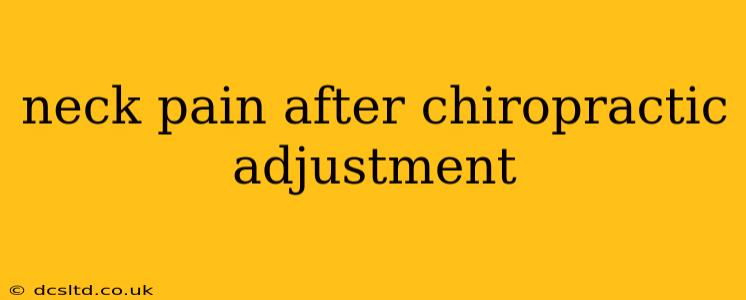Neck pain is a common complaint, and while chiropractic adjustments are often effective in alleviating it, some individuals experience temporary worsening of pain afterward. This isn't necessarily a cause for alarm, but understanding why it happens and what to do about it is crucial. This comprehensive guide will delve into the potential reasons behind post-adjustment neck pain, address frequently asked questions, and offer advice on managing discomfort.
Why Does My Neck Hurt After a Chiropractic Adjustment?
Several factors can contribute to neck pain following a chiropractic adjustment. It's important to remember that while adjustments aim to improve spinal alignment and reduce pain, the process itself can temporarily trigger some discomfort. This is often due to:
- Muscle Soreness: Adjustments can cause microscopic muscle tears, leading to temporary soreness and stiffness similar to the feeling after a strenuous workout. This is a normal response to the manipulation and usually subsides within a day or two.
- Inflammation: The adjustment may temporarily increase inflammation in the affected area. This inflammatory response is the body's natural healing process, but it can cause pain and swelling.
- Ligament Strain: Gentle stretching of ligaments during the adjustment might cause mild discomfort. This is usually short-lived and resolves quickly.
- Referred Pain: Pain experienced in the neck might actually originate from a different area, such as the shoulders, upper back, or even the jaw. The adjustment might temporarily increase sensitivity in the neck, revealing underlying issues.
- Improper Technique: While rare with qualified chiropractors, improper technique can lead to increased pain or even injury. This highlights the importance of choosing a qualified and experienced practitioner.
How Long Does Neck Pain After a Chiropractic Adjustment Last?
The duration of post-adjustment neck pain varies significantly depending on several factors, including the individual's overall health, the severity of the initial condition, and the type of adjustment performed. Most often, the pain is mild and resolves within 24 to 48 hours. However, some individuals may experience discomfort for up to a week. If pain persists beyond a week or worsens significantly, it's crucial to contact your chiropractor.
Is Neck Pain After a Chiropractic Adjustment Normal?
Some degree of temporary discomfort is considered relatively normal after a chiropractic adjustment. This is often a sign that the body is responding to the manipulation and beginning the healing process. However, the pain should be mild and short-lived. Severe, persistent, or worsening pain is not normal and requires immediate attention.
What Should I Do if My Neck Hurts After a Chiropractic Adjustment?
If you experience mild neck pain after an adjustment, several self-care measures can help alleviate the discomfort:
- Rest: Avoid strenuous activities that could exacerbate the pain.
- Ice: Apply ice packs to the affected area for 15-20 minutes at a time, several times a day. Ice helps reduce inflammation.
- Over-the-counter pain relievers: Ibuprofen or acetaminophen can help manage pain and inflammation.
- Gentle stretching: Once the initial pain subsides, gentle stretches can help improve range of motion and reduce stiffness. However, avoid any movements that cause increased pain.
- Heat: After the initial 24-48 hours, heat therapy may be beneficial to relax muscles and increase blood flow.
- Follow your chiropractor's instructions: Your chiropractor will likely provide specific post-adjustment care recommendations. Follow their advice carefully.
When Should I See a Doctor After a Chiropractic Adjustment?
While some discomfort is expected, it's crucial to seek medical attention if:
- Your neck pain is severe or worsens over time.
- You experience numbness, tingling, or weakness in your arms or hands.
- You have difficulty swallowing or breathing.
- You develop a headache that is unusually severe or persistent.
- Your pain persists for more than a week.
This information is intended for educational purposes only and should not be considered medical advice. Always consult with a qualified healthcare professional for diagnosis and treatment of any medical condition. The experience of each individual is unique; it’s vital to communicate openly with your chiropractor to address any concerns.
